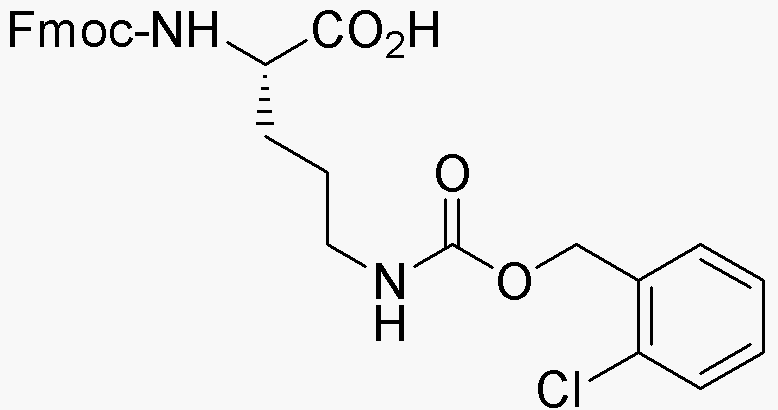Na-Fmoc-Nd-2-chloro-Z-L-ornithine is widely utilized in research focused on:
- Peptide Synthesis: This compound serves as a key building block in the synthesis of peptides, particularly in the development of therapeutic agents. Its unique structure allows for the incorporation of specific functionalities that enhance peptide stability and activity.
- Drug Development: In pharmaceutical research, it is used to create novel drug candidates, especially in the field of cancer therapy. The ability to modify its structure enables researchers to optimize drug efficacy and reduce side effects.
- Bioconjugation: The compound can be employed in bioconjugation processes, linking biomolecules to drugs or imaging agents. This application is crucial in targeted therapy, allowing for precise delivery of therapeutics to specific cells.
- Protein Engineering: It plays a significant role in protein engineering, where it is used to modify proteins for improved functionality. This is particularly beneficial in enzyme design and antibody development, enhancing their performance in various applications.
- Research in Neuroscience: The compound is also explored in neuroscience research, where it aids in the study of neuropeptides and their roles in signaling pathways. This can lead to advancements in understanding neurological disorders and developing new treatment strategies.
Información general
Propiedades
Seguridad y normativas
Aplicaciones
Na-Fmoc-Nd-2-chloro-Z-L-ornithine is widely utilized in research focused on:
- Peptide Synthesis: This compound serves as a key building block in the synthesis of peptides, particularly in the development of therapeutic agents. Its unique structure allows for the incorporation of specific functionalities that enhance peptide stability and activity.
- Drug Development: In pharmaceutical research, it is used to create novel drug candidates, especially in the field of cancer therapy. The ability to modify its structure enables researchers to optimize drug efficacy and reduce side effects.
- Bioconjugation: The compound can be employed in bioconjugation processes, linking biomolecules to drugs or imaging agents. This application is crucial in targeted therapy, allowing for precise delivery of therapeutics to specific cells.
- Protein Engineering: It plays a significant role in protein engineering, where it is used to modify proteins for improved functionality. This is particularly beneficial in enzyme design and antibody development, enhancing their performance in various applications.
- Research in Neuroscience: The compound is also explored in neuroscience research, where it aids in the study of neuropeptides and their roles in signaling pathways. This can lead to advancements in understanding neurological disorders and developing new treatment strategies.
Documentos
Hojas de datos de seguridad (HDS)
La SDS proporciona información de seguridad completa sobre la manipulación, el almacenamiento y la eliminación del producto.
Especificación del producto (PS)
La PS proporciona un desglose completo de las propiedades del producto, incluida la composición química, el estado físico, la pureza y los requisitos de almacenamiento. También detalla los rangos de calidad aceptables y las aplicaciones previstas del producto.
Certificados de análisis (COA)
Busque certificados de análisis (COA) ingresando el número de lote del producto. Los números de lote y de partida se pueden encontrar en la etiqueta de un producto después de las palabras "Lote" o "Lote".
Número de catálogo
Número de lote/lote
Certificados de origen (COO)
Este certificado de origen confirma el país en el que se fabricó el producto y también detalla los materiales y componentes utilizados en él y si se deriva de fuentes naturales, sintéticas u otras fuentes específicas. Este certificado puede ser necesario para cumplir con las normativas aduaneras, comerciales y regulatorias.
Número de catálogo
Número de lote/lote
Hojas de datos de seguridad (HDS)
La SDS proporciona información de seguridad completa sobre la manipulación, el almacenamiento y la eliminación del producto.
DownloadEspecificación del producto (PS)
La PS proporciona un desglose completo de las propiedades del producto, incluida la composición química, el estado físico, la pureza y los requisitos de almacenamiento. También detalla los rangos de calidad aceptables y las aplicaciones previstas del producto.
DownloadCertificados de análisis (COA)
Busque certificados de análisis (COA) ingresando el número de lote del producto. Los números de lote y de partida se pueden encontrar en la etiqueta de un producto después de las palabras "Lote" o "Lote".
Número de catálogo
Número de lote/lote
Certificados de origen (COO)
Este certificado de origen confirma el país en el que se fabricó el producto y también detalla los materiales y componentes utilizados en él y si se deriva de fuentes naturales, sintéticas u otras fuentes específicas. Este certificado puede ser necesario para cumplir con las normativas aduaneras, comerciales y regulatorias.


